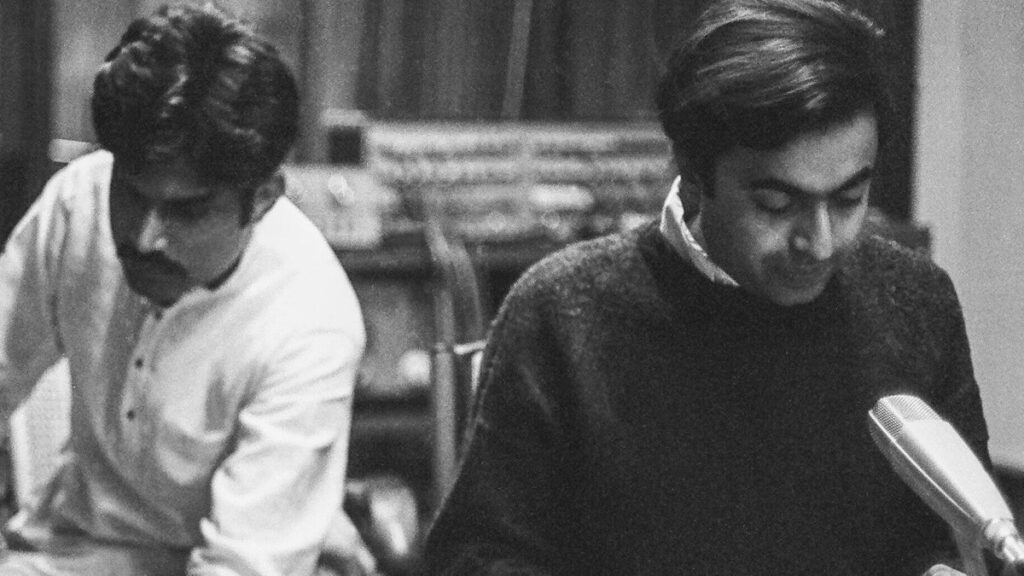
One night in 1969, 20,000 people gathered at the National Institute of Design in Ahmedabad, in the Indian state of Gujarat, to witness a vision of the future: the Moog synthesizer. An audiovisual spectacle called Soundscape was taking place across campus, and students and faculty members played the instrument while those in attendance marveled at the cutting-edge technology. American composer David Tudor had arrived in India earlier that year; during his three-month residency, he installed the synthesizer, which had been shipped from New York in wooden crates, along with a Dual Ring Modulator, a Bode Frequency Shifter, and tape machines, and led workshops on the instrument. Like the European electronic music studios established in the 1950s, the NID’s space would become a hub for exploration, hosting students of various stripes to experiment with its tools’ endless capabilities.
The first overview of this short-lived but groundbreaking period comes in the form of a tremendous new compilation, The NID Tapes: Electronic Music from India 1969-1972. The artist Paul Purgas discovered, reassembled, and digitized its 19 tracks from 27 tape reels, and the results are thrillingly varied. Across tape collages and soundtracks, improvisations and field recordings, the overarching feeling is one of restless curiosity. Gita Sarabhai’s two pieces—both simply titled “Gitaben’s Composition”—are emblematic of these studio investigations. Her first contribution features playful, cartoonish warbles reverberating in the ether. The latter takes us straight into the void, casting lambent, oscillating tones into a monolithic drone.
Sarabhai was a musicologist and revered musician who came from an influential family that pushed for modernist changes in the country. The pedagogical philosophies they favored infused the principles of Maria Montessori and the Bauhaus with ideas of holistic training via Mahatma Gandhi. It was Sarabhai who oversaw Tudor’s residency, and even prior to this international exchange, she would play records from her personal collection—Western composers like John Cage and Karlheinz Stockhausen, Indian musicians like Ravi Shankar and Kesarbai Kerkar—over the PA system during the NID’s lunch hours. This stylistic mélange animates Atul Desai’s “Compositions,” whose commingling of percussion and effervescent bleeps channel his desire to seek naad—the ever-vibrating “essence of sound.” This isn’t so much a transition from past to present as an expression of music’s liberatory potential: Given the rigors and hierarchies inherent in learning the sitar or sarod, for example, the Moog symbolized a more egalitarian avenue for ecstatic stimulation of the mind, body, and spirit.
On an All India Radio broadcast from 1970, Desai, a Hindustani classical vocalist and composer, and the filmmaker I.S. Mathur extolled the avant-garde composer Edgard Varèse; their reverence for the early-20th-century experimentalist is evident in Mathur’s own pieces. The desire to blend environmental sounds with electronics is the central premise behind the impish “My Birds,” while “Soundtrack of Shadow Play” is an invigorating slab of musique concrète in the lineage of Varèse’s Poème électronique. Without the actual theatrical performance to view, its recordings of balmy Indian percussion transform into acousmatic abstractions amid a sea of calming electronic tones. Elsewhere, Mathur’s “Once I Played a Tanpura” captures a scorching solo on the titular instrument. And for those wanting to feel stressed beyond belief, “Shadows of the Show” intermittently recalls the hypnotic illusion of a Shepard tone, continually rising in pitch and intensity as if continually on the verge of exploding.
The NID Tapes directly challenges Western conceptions of Indian culture. Three years after the Beatles drew from Indian classical music for Revolver, an architecture student named Jinraj Joshipura looked not to old musical forms but to the next century, composing science-fiction pieces inspired by James Bond flicks and Kubrick’s 2001: A Space Odyssey. His two “Space Liner 2001” tracks aim to capture previously unheard sounds, and their unadorned electronic thrumming embodies the empty expanse of the cosmos. The second of his compositions is like a foley artist’s work for an imaginary film—with patience and quietude, he captures the minimalist noises that would accompany an astronaut’s trek through outer space.
The tracks unearthed on The NID Tapes are often sparse in this way, and all the more striking for it. Take S.C. Sharma’s “After the War,” whose synths waver at various tempos to create textural and rhythmic complexity. Expertly mixed to take advantage of stereo imaging, its layered blips and clangs echo the full-body immersion associated with raga. Most mind-blowing are his “Dance Music” compositions. They loop in dizzying fashion, carrying a sinister undercurrent far removed from the cheeseball charm of Moog pioneers like Perrey & Kingsley or Dick Hyman. “Dance Music II” and “III” do have a subtle air of whimsy, placing them as a precursor to Charanjit Singh’s 1982 LP of acid-tinged disco. “Dance Music I,” especially, is an all-timer: Taking shape from winding, low-pitched pulses, it feels like the primordial ooze from which dub techno evolved.
Alongside these works by Indian artists is one by Tudor himself. His 1969 piece “Tape Feedback With Moog” is representative of the elemental power that defines this compilation. For three minutes, he explores gnarly cacophony, weaving a more immediate and economical tapestry of noise than what he made with Anima Pepsi and Pepsibird in the following year. If there is a track that captures the world-building of Tudor’s more characteristic work, it is Desai’s “Recordings for Osaka Expo 70,” whose tape-processed sounds form a kaleidoscopic survey of traditional Indian music. “This music must reach the masses,” Desai said more than 50 years ago about these innovative electronic investigations. “And the listeners must be made to realize the vast potential of this sound world.” His demanding tone feels warranted: The NID Tapes is eye-opening and rich, its discoveries too revolutionary to ignore.
